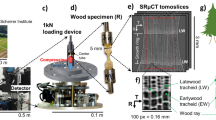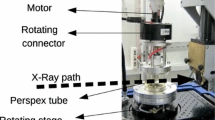Abstract
Local defects in cellulose fibres, commonly referred to as microcompressions, increase the apparent strain to fracture in paper, an increasingly important parameter for products demanding stretch. This study presents an investigation into the origin of microcompressions by examining the behaviour of aspen wood under uniaxial compression applied along the grain, a process mimicking the action of a screw press and refiners during mechanical pulping. Using X-ray micro-computed tomography, a series of 10 tomograms with 30 µm of compressive deformation between images were acquired at 1.2 µm voxel size. For each tomogram, image analysis routines were developed to segment and label individual tracheids, vessel and ray elements, and track their motion between sequential frames. We classified the evolution of the axial trajectory of each element as either non-buckled or buckled, with a prominent presence of microcompression with axial deformations of less than 3%. We argue that microcompression precedes buckling. Significantly, we advance that localized deformation events (microcompressions, buckling, telescopic shortening) nucleate near vessel elements, and spread with increasing levels of compression; no particular structure appears to be immune to collapse. Finally, we liberated fibres in the compressed sample through chemical pulping and found that the damage occurring from compression was permanent.





Similar content being viewed by others
Data Availability Statement
X-ray micro-computed tomography volumes will be made available upon reasonable request.
References
Bodig J, Jayne BA (1982) Mechanics of wood and wood composites. Van Nostrand Reinhold, New York, pp 10–22
Borrega M, Gibson LJ (2015) Mechanics of balsa (ochroma pyramidale) wood. Mech Mater 84:75–90. https://doi.org/10.1016/j.mechmat.2015.01.014
Burgert I, Bernasconi A, Eckstein D (1999) Evidence for the strength function of rays in living trees. Europ J Wood Wood Prod 57(5):397–399. https://doi.org/10.1007/s001070050367
Burgert I, Bernasconi A, Niklas K et al (2001) The influence of rays on the transverse elastic anisotropy in green wood of deciduous trees. Holzforschung 55(5):449–454. https://doi.org/10.1515/HF.2001.074
Chamas A, Moon H, Zheng J et al (2020) Degradation rates of plastics in the environment. ACS Sustain Chem Eng 8(9):3494–3511. https://doi.org/10.1021/acssuschemeng.9b06635
Côté W, Hanna R (1983) Ultrastructural characteristics of wood fracture surfaces. Wood Fiber Sci 88:135–163
Da Silva A, Kyriakides S (2007) Compressive response and failure of balsa wood. Int J Solids Struct 44(25):8685–8717. https://doi.org/10.1016/j.ijsolstr.2007.07.003
Dinwoodie J (1975) Timber-a review of the structure-mechanical property relationship. J Microsc 104(1):3–32. https://doi.org/10.1111/j.1365-2818.1975.tb04002.x
Ellis S, Steiner P (2002) The behaviour of five wood species in compression. IAWA J 23(2):201–211
Geyer R, Jambeck JR, Law KL (2017) Production, use, and fate of all plastics ever made. Sci Adv 3(7):e1700782. https://doi.org/10.1126/sciadv.1700782
Gibson LJ, Ashby MF (1997) Cellular solids: structure and properties, 2nd edn. Cambridge University Press, Cambridge
Gindl W, Teischinger A (2002) Axial compression strength of norway spruce related to structural variability and lignin content. Compos Part A Appl Sci Manuf 33(12):1623–1628. https://doi.org/10.1016/S1359-835X(02)00182-3
Grossman P, Wold M (1971) Compression fracture of wood parallel to the grain. Wood Sci Technol 5(2):147–156. https://doi.org/10.1007/BF01134225
Hamad WY, Gurnagul N, Gulati D (2012) Analysis of fibre deformation processes in high-consistency refining based on Raman microscopy and x-ray diffraction. Holzforschung 66(6):711–716. https://doi.org/10.1515/hf-2012-0502
Hartler N (1995) Aspects on curled and microcompressed fibers. Nordic Pulp Paper Res J 10(1):4–7. https://doi.org/10.3183/npprj-1995-10-01-p004-007
Haslach HW Jr (1996) A model for drying-induced microcompressions in paper: buckling in the interfiber bonds. Compos Part B Eng 27(1):25–33. https://doi.org/10.1016/1359-8368(95)00003-8
Huang C, Gong M, Chui Y et al (2020) Mechanical behaviour of wood compressed in radial direction-part I new method of determining the yield stress of wood on the stress-strain curve. J Bioresou Bioprod 5(3):186–195. https://doi.org/10.1016/j.jobab.2020.07.004
Kibblewhite RP, Kerr AJ (1980) Fibre, wet web and paper properties of bisulphite pulps treated with gaseous ammonia. APPITA J 33(4):102
Kučera L, Bariska M (1982) On the fracture morphology in wood: part 1: a SEM-study of deformations in wood of spruce and aspen upon ultimate axial compression load. Wood Sci Technol 16(4):241–259. https://doi.org/10.1007/BF00353147
Legland D, Arganda-Carreras I, Andrey P (2016) MorphoLibJ: integrated library and plugins for mathematical morphology with ImageJ. Bioinformatics 32(22):3532–3534. https://doi.org/10.1093/bioinformatics/btw413
Mäkinen T, Halonen A, Koivisto J et al (2022) Wood compression in four-dimensional in situ tomography. Phys Rev Mater 6:L070601. https://doi.org/10.1103/PhysRevMaterials.6.L070601
Nanko H, Ohsawa J (1989) Mechanisms of fibre bond formation. Fundam Papermak 2:783–830
Nanko H, Wu J (1995) Mechanisms of paper shrinkage during drying. International paper physics conference. Niagara-on-the-Lake, Canada, pp 103–113
Nyholm K, Ander P, Bardage S et al (2001) Dislocations in pulp fibres-their origin, characteristics and importance-a review. Nordic Pulp Paper Res J 16(4):376–384. https://doi.org/10.3183/npprj-2001-16-04-p376-384
Otsu N (1979) A threshold selection method from gray-level histograms. IEEE Trans Syst Man Cybern 9(1):62–66. https://doi.org/10.1109/TSMC.1979.4310076
Page DH, Seth RS (1980) The elastic modulus of paper III the effects of dislocations, microcompressions, curl, crimps, and kinks. Tappi 63(10):99–102
Page DH, Tydeman P (1962) A new theory of the shrinkage, structure and properties of paper. In: Bolam F (ed) The formation and structure of paper, vol 1. Transactions of the Oxford Symposium, p 397–425
Paliwal K, Agarwal A, Sinha SS (1982) A modification over Sakoe and Chiba’s dynamic time warping algorithm for isolated word recognition. Signal Process 4(4):329–333. https://doi.org/10.1016/0165-1684(82)90009-3
Poulsen JS, Moran P, Shih C et al (1997) Kink band initiation and band broadening in clear wood under compressive loading. Mech Mater 25(1):67–77. https://doi.org/10.1016/S0167-6636(96)00043-9
Reiterer A, Stanzl-Tschegg SE (2001) Compressive behaviour of softwood under uniaxial loading at different orientations to the grain. Mechan Mater 33(12):705–715. https://doi.org/10.1016/S0167-6636(01)00086-2
Reiterer A, Burgert I, Sinn G et al (2002) The radial reinforcement of the wood structure and its implication on mechanical and fracture mechanical properties-a comparison between two tree species. J Mater Sci 37:935–940. https://doi.org/10.1023/A:1014339612423
Rochman CM, Tahir A, Williams SL et al (2015) Anthropogenic debris in seafood: Plastic debris and fibers from textiles in fish and bivalves sold for human consumption. Sci Rep 5(1):14340. https://doi.org/10.1038/srep14340
Sakoe H, Chiba S (1978) Dynamic programming algorithm optimization for spoken word recognition. IEEE Trans Acoust Speech Signal Process 26(1):43–49. https://doi.org/10.1109/TASSP.1978.1163055
Sanabria SJ, Baensch F, Zauner M et al (2020) In-situ quantification of microscopic contributions of individual cells to macroscopic wood deformation with synchrotron computed tomography. Sci Rep 10(1):1–16. https://doi.org/10.1038/s41598-020-78028-4
Schindelin J, Arganda-Carreras I, Frise E et al (2012) Fiji: an open-source platform for biological-image analysis. Nature Methods 9(7):676–682. https://doi.org/10.1038/nmeth.2019
Seth R, Page D (1981) The stress-strain curve of paper. Role Fundam Res Paper Mak 10: 421–452. https://doi.org/10.15376/frc.1981.1.421
Seth RS (2005) Understanding sheet extensibility. Pulp Paper Canada 106(2):33–40
Shen M, Huang W, Chen M et al (2020) (Micro)plastic crisis: un-ignorable contribution to global greenhouse gas emissions and climate change. J Cleaner Product 254:120138. https://doi.org/10.1016/j.jclepro.2020.120138
Steppe K, Cnudde V, Girard C et al (2004) Use of x-ray computed microtomography for non-invasive determination of wood anatomical characteristics. J Struct Biol 148(1):11–21. https://doi.org/10.1016/j.jsb.2004.05.001
Tao J, Evans P, Qin Q, et al. (2015) Mechanical characterisation of willow based on micro-CT and digital volume correlation (DVC) analysis. In: 2nd International Conference on Natural Fibers
The MathWorks Inc. (2022) MATLAB version: 9.13.0 (R2022b). https://www.mathworks.com
Tschumperle D, Deriche R (2005) Vector-valued image regularization with PDEs: a common framework for different applications. IEEE Trans Patt Anal Mach Intell 27(4):506–517. https://doi.org/10.1109/TPAMI.2005.87
Tuomela M, Vikman M, Hatakka A et al (2000) Biodegradation of lignin in a compost environment: a review. Bioresour Technol 72(2):169–183. https://doi.org/10.1016/S0960-8524(99)00104-2
Vishtal A, Retulainen E (2014) Boosting the extensibility potential of fibre networks: a review. BioResources 9(4):7951–8001
Wright SL, Thompson RC, Galloway TS (2013) The physical impacts of microplastics on marine organisms: a review. Environ Pollut 178:483–492. https://doi.org/10.1016/j.envpol.2013.02.031
Yushkevich PA, Piven J, Cody Hazlett H et al (2006) User-guided 3D active contour segmentation of anatomical structures: significantly improved efficiency and reliability. Neuroimage 31(3):1116–1128. https://doi.org/10.1016/j.neuroimage.2006.01.015
Zauner M (2014) In-situ synchrotron based tomographic microscopy of uniaxially loaded wood: in-situ testing device, procedures and experimental investigations. PhD thesis, ETH Zurich, https://doi.org/10.3929/ethz-a-010105977
Zauner M, Keunecke D, Mokso R et al (2012) Synchrotron-based tomographic microscopy (SbTM) of wood: development of a testing device and observation of plastic deformation of uniaxially compressed norway spruce samples. Holzforschung 66(8):973–979. https://doi.org/10.1515/hf-2011-0192
Zauner M, Stampanoni M, Niemz P (2016) Failure and failure mechanisms of wood during longitudinal compression monitored by synchrotron micro-computed tomography. Holzforschung 70(2):179–185. https://doi.org/10.1515/hf-2014-0225
Zeng X, Vishtal A, Retulainen E et al (2012) The elongation potential of paper-how should fibres be deformed to make paper extensible? BioResources 8(1):472–486
Acknowledgments
This research was supported in part through computational resources and services provided by Advanced Research Computing at the University of British Columbia.
Funding
This work was conducted as part of the Energy Reduction in Mechanical Pulping program, funded by a Collaborative Research and Development Grant provided by the Natural Sciences and Engineering Research Council of Canada (NSERC) (Grant No. CRDPJ 538628-19) and the following partners: AB Enzymes, Alberta Newsprint Company, BC Hydro, BC Institute of Technology, Canfor, Paper Excellence, FPInnovations, Holmen Paper, McMaster University, Millar Western, The University of British Columbia Pulp and Paper Centre, University of Victoria, West Fraser, and Valmet, who we greatly thank for their continuous support.
Author information
Authors and Affiliations
Contributions
SNMB: Conceptualization, Formal Analysis, Investigation, Methodology, Software, Validation, Visualization, Writing - original draft, Writing - review & editing. AS: Conceptualization, Formal Analysis, Investigation, Methodology, Software, Supervision, Validation, Visualization, Writing - review & editing. JD: Conceptualization, Methodology, Investigation, Resources, Writing - review & editing. JC: Conceptualization, Methodology, Writing - review & editing. RB: Conceptualization, Methodology, Writing - review & editing. AP: Conceptualization, Methodology, Supervision, Writing - review & editing. DMM: Conceptualization, Funding acquisition, Methodology, Project administration, Supervision, Visualization, Writing - review & editing.
Corresponding author
Ethics declarations
Conflict of interest
The authors declare no competing interests.
Ethical approval
Not applicable.
Additional information
Publisher's Note
Springer Nature remains neutral with regard to jurisdictional claims in published maps and institutional affiliations.
Rights and permissions
Springer Nature or its licensor (e.g. a society or other partner) holds exclusive rights to this article under a publishing agreement with the author(s) or other rightsholder(s); author self-archiving of the accepted manuscript version of this article is solely governed by the terms of such publishing agreement and applicable law.
About this article
Cite this article
Brown, S.N.M., Sibellas, A., Drummond, J. et al. Understanding the origin of microcompressions in cellulose fibres using 4D X-ray micro-computed tomography. Cellulose 31, 1383–1395 (2024). https://doi.org/10.1007/s10570-023-05693-9
Received:
Accepted:
Published:
Issue Date:
DOI: https://doi.org/10.1007/s10570-023-05693-9




